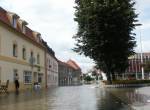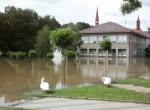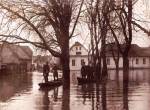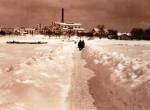
The educational journey of the robber Stetka
A nature trail around the surroundings of Štětí for the whole family, introducing the history and picturesque nature, industry and agriculture of Štetsko. The legendary robber Štětka and his four-member team are guiding the tour, giving information on a marked circuit starting from
In the old days of the Thirty Years' War, the robber Štětka was the master of the deep forests, fields and hillsides around the town of Štětí. Today, his home is the former Mordloch Cave, hidden away from people in the middle of the Stračen forests. Who knows him in the region. He protects the poor and honest, and justly punishes dishonesty and avarice. He has walked this land many times. He knows every road and footpath here.
During your adventurous journey with the robber Stetka you will come across educational boards that will tell you all about the history, nature, fauna and flora, industry and agriculture of the local region or visit the mythical cave Mordloch of the robber Stetka. You can also try out a discovery competition Following the footsteps of the robbers or robber geocaching.
Stops
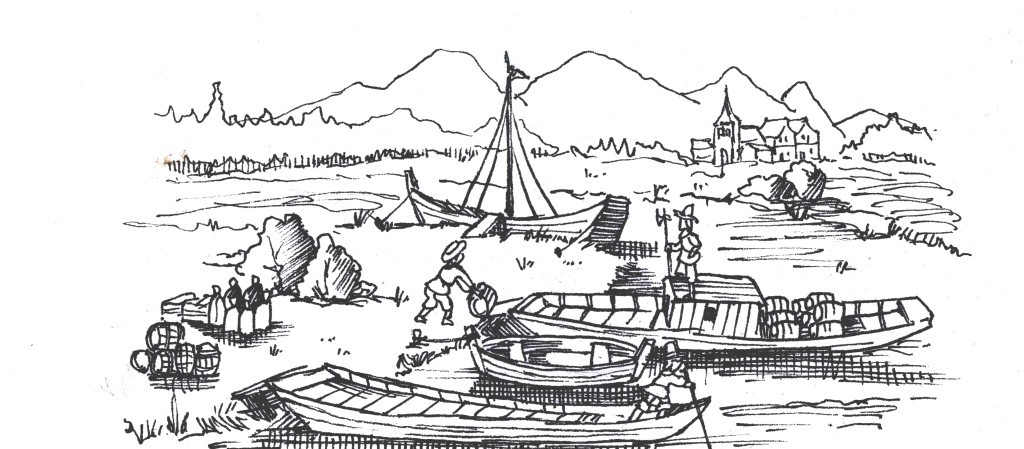
Štětí, Elbe
LABE - FLOODS AND SHIPPING
Floods in the past
The dwellings, located close to the riverbed, were still threatened by frequent floods, especially during the spring snowmelt and subsequent ice retreat, but also during summer storms. There were of course no large annual floods, but exceptionally large floods were recorded in 1636, 1658, 1784, 1821, 1827, 1842, 1845, 1890, 1935 and 1965, and in particular the largest so far in 2002.
During the flood of 1784, the existing wooden church in Štětská was destroyed by the high water. The brick tower with two bells apparently withstood the onslaught of water and ice bushes. At the same time, the parish building took its toll and 72 houses were only badly damaged. His deed was recorded by the town syndic Mück in the German town protocol book with all the details: 'When the water came with all its might into his cell at night around two o'clock, he broke through the ceiling, climbed up to the attic and lifted his wife and three children up there - the youngest was 3 weeks old. No sooner had this been done than the walls of the house gave way under the pressure of the ice, the ceiling collapsed, and the wife and children fell back down into the water. Reichelt climbed up the dormer, waded over to the window and saw his wife and children lying in the water under the collapsed ceiling. Miraculously, they were unharmed. Gradually, he carried them out through the icy flood to a nearby unheated barn..."
In 1827, high water and ice carried away the sand island near Počeplice and tore off a part of the town island near Štětí, so that sandbanks were formed on the shore in front of the town. At that time, three steep rock blocks also protruded from the Elbe riverbed. In 1842, a prolonged drought caused so little water to flow in the river that the ferry was unable to transport water at all during the summer. It was also unnecessary, as people waded to Hněvice on foot, and the water reached no higher than their knees. The ship millers had to mill for the peasants from far away, because the mills on the streams had no water all summer. The following winter was again so mild that the Elbe did not freeze and the ship mills could mill all winter. On the other hand, after the exceptionally severe winter of 1844-1845, the river was still gripped by a thick sheet of ice on 22 March, so that the floats could travel on the other side. Then came a sudden thunderstorm, which caused a flood in which the level rose even 0.5 m higher than in 1784. In the church the water stood 0.5 m above the pavement and 76 houses near the river were flooded and some of them collapsed. A total of 28 houses became uninhabitable.
The last, and at the same time the biggest, flood hit the town of Štětí in August 2002. The swollen Elbe River reached the border of the pedestrian zone and the new square before its peak. Dohnalova Street, houses on Hus Square, the Church of St. Simon and Jude, the Higher Vocational School, and the Penny Market shop are under water. The swollen river is also flooding the Szczecin paper mill, which is interrupting operations.
Crossing the Elbe
In the earliest times there was probably a ford across the river, which could be crossed all year round on horseback. In dry years, people used to wade across the river on foot in summer when the water level was low. When the river froze in winter, people walked across the river on the ice. As the population grew on both sides of the river, this risky method of crossing ceased to be suitable, and the river became a ferry boat or ferry. The right to ferry across the Elbe was granted to the town of Štětí as early as 1557 by King Ferdinand I. In 1851 a pontoon bridge, or rather a footbridge, was built across the Elbe to facilitate access to the new railway station in Hněvice. The footbridge was called the flying bridge, probably because it was swaying on the Elbe's surface. This Szczecin attraction was dismantled together with the ship mills during the regulation of the Elbe riverbed in 1908. After that, only the Elbe ferry carried passengers again until the new bridge was completed in 1973. The access road on the Hněvická side of the river and the waiting room still show the location of the former ferry port.
Shipping
Boat traffic on the Elbe was only sporadic in the past, only in spring and autumn, as the river was not flowing well in summer and froze in winter. Cargo ships and mainly longline rafts floated downstream. Horse-drawn freighters, and later steamboats, passed upstream. The horse-drawn waterway ran along the left bank, so it had no direct contact with the Shtetl. In 1885 a chain was laid in the river for the navigation of steamboats on the chain. Passenger steamers began carrying passengers in 1841. After a temporary interruption in service, passenger service was resumed in 1885. At the beginning of the 20th century, the 'canalisation' of the Elbe was carried out to both mitigate the effects of the frequent devastating floods and to ensure that shipping had sufficient water for as many days of the year as possible.
The consistent regulation of the Elbe riverbed and the sophisticated system of weirs with locks fulfilled this expectation. On the lower Elbe in northern Bohemia, weirs were built in 1903-1919 at Dolní Beřkovice, at Račice, at Roudnice n. L., at České Kopiste and at Lovosice, which were built gradually downstream. These weirs were equipped with sluice gates and spider culverts. The weirs were dismantled in winter to prevent ice jams during sudden thaws. The weirs with locks and the deepened Elbe riverbed with a stabilised draught depth greatly facilitated freight and passenger shipping. In the interwar period of the 20th century, regular passenger transport operated on the regulated Elbe according to a timetable, with a stop at Štětí, but outside the winter months.

